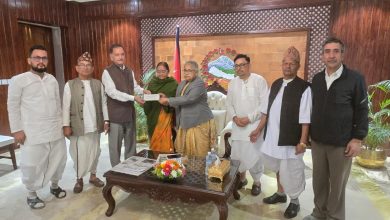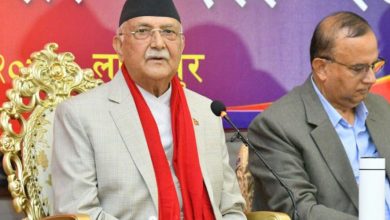Huge methane gas storage confirmed in Dailekh’s reservoir
Dailekh: Signs of hope that will brighten Nepal’s future are starting to appear from the waters of Dailekh.
The China Geological Survey Company has submitted a preliminary report on petroleum and natural gas exploration in Dailekh to the Nepal government. It has revealed that the Jaljale area is a huge storage site for methane gas.
 The first drilling operation, which began in 2078 BS, was carried out to a depth of 4,013 meters. The testing of samples collected from there has confirmed the presence of 1.12 billion cubic meters of methane gas storage.
The first drilling operation, which began in 2078 BS, was carried out to a depth of 4,013 meters. The testing of samples collected from there has confirmed the presence of 1.12 billion cubic meters of methane gas storage.
This is only the initial result of the first well out of a total of four possible wells. According to the initial estimates of the remaining three wells, a total of 430 billion cubic meters of gas is projected to be present in the Jaljale area. This has the potential to meet Nepal’s gas needs for about 50 years.
According to Dinesh Kumar Napit, Deputy Director General of the Department of Mines and Geology and Head of the Petroleum Exploration Project, this work was started after the G2G agreement between Nepal and China in 2019. “The Nepal government has allocated 45 ropanis of government land in the Jaljale area of Dailekh for exploration purposes and has launched the project. This is the deepest and most scientifically completed exploration project to date,” Napit said.
According to him, the report received so far is preliminary. More detailed tests are being conducted on the quality of the gas, the feasibility of commercial production, and the economic benefits. The Chinese company is preparing to submit a final report by December 2025. After that, the government plans to start commercial production trials within December.
The sight of self-igniting gas and oil-like substances leaking from the ground in Dailekh is not new to the locals. However, efforts have been made to scientifically confirm this since 2036 BS. After the promulgation of the constitution in 2072 BS, the blockade imposed by India created a fuel crisis throughout the country. After this, the government was forced to become serious about indigenous energy sources. In that context, Dailekh came back to the center of discussion.
This crisis created an opportunity. Nepal focused seriously on the possibility of identifying and extracting indigenous resources for the first time. The agreement signed between Nepal and China for petroleum exploration in 2075 BS is not only a technological advance, but also carries a strategic message.
In the initial investigation, Nepali and Chinese technicians confirmed that the gas flowing continuously in the Shirsthan and Nabhisthan areas of Dailekh is petroleum. The technicians estimate that there are petrol and gas mines in six to seven places in Dailekh.
A survey conducted long ago also found the possibility of petroleum or gas here. In the next phase, its quantity and quality have been determined in detail. The current project is a pilot project fully funded by China.
It is being implemented with the financial and technical support of the Chinese government’s Geological Survey. Its initial cost was estimated at Rs 2.5 billion. The cost also increased due to delays in implementation due to various reasons, including the COVID-19 pandemic.
The Department of Mines and Geology of the Government of Nepal had established the ‘Petroleum Exploration Promotion Project’ and facilitated the work of land acquisition, expansion of road and electricity access, and administrative coordination. This did not encounter any obstacles from local people’s representatives, administrative machinery, or any other party.
The residents of Dailekh and stakeholders are excited after the project finally came to fruition. Narendra Thapa, President of the Dailekh Chamber of Commerce and Industry, informed that the manpower involved in mining, processing, supply chain and technical work will increase employment opportunities at the local level and create an industry-friendly environment.
It is believed that this project could prove to be a historic opportunity for the country’s energy security. If the initial estimates of storage are confirmed, Nepal will gradually free itself from dependence on fuel imports and reach a state where it can produce and distribute energy from domestic sources.









Comments